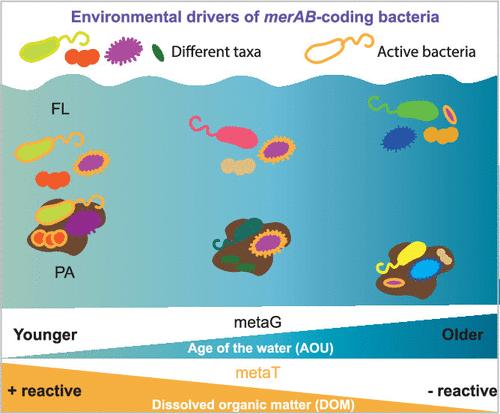当前位置:
X-MOL 学术
›
Environ. Sci. Technol.
›
论文详情
Our official English website, www.x-mol.net, welcomes your feedback! (Note: you will need to create a separate account there.)
Microorganisms Involved in Methylmercury Demethylation and Mercury Reduction are Widely Distributed and Active in the Bathypelagic Deep Ocean Waters
Environmental Science & Technology ( IF 10.8 ) Pub Date : 2024-07-24 , DOI: 10.1021/acs.est.4c00663 Isabel Sanz-Sáez 1 , Andrea G. Bravo 1 , Marta Ferri 1 , Joan-Martí Carreras 1 , Olga Sánchez 2 , Marta Sebastian 1 , Clara Ruiz-González 1 , Eric Capo 1 , Carlos M. Duarte 3 , Josep M. Gasol 1 , Pablo Sánchez 1 , Silvia G. Acinas 1
Environmental Science & Technology ( IF 10.8 ) Pub Date : 2024-07-24 , DOI: 10.1021/acs.est.4c00663 Isabel Sanz-Sáez 1 , Andrea G. Bravo 1 , Marta Ferri 1 , Joan-Martí Carreras 1 , Olga Sánchez 2 , Marta Sebastian 1 , Clara Ruiz-González 1 , Eric Capo 1 , Carlos M. Duarte 3 , Josep M. Gasol 1 , Pablo Sánchez 1 , Silvia G. Acinas 1
Affiliation

|
The ocean’s mercury (Hg) content has tripled due to anthropogenic activities, and although the dark ocean (>200 m) has become an important Hg reservoir, concentrations of the toxic and bioaccumulative methylmercury (MeHg) are low and therefore very difficult to measure. As a consequence, the current understanding of the Hg cycle in the deep ocean is severely data-limited, and the factors controlling MeHg, as well as its transformation rates, remain largely unknown. By analyzing 52 globally distributed bathypelagic deep-ocean metagenomes and 26 new metatranscriptomes from the Malaspina Expedition, our study reveals the widespread distribution and expression of bacterial-coding genes merA and merB in the global bathypelagic ocean (∼4000 m depth). These genes, associated with HgII reduction and MeHg demethylation, respectively, are particularly prevalent within the particle-attached fraction. Moreover, our results indicate that water mass age and the organic matter composition shaped the structure of the communities harboring merA and merB genes living in different particle size fractions, their abundance, and their expression levels. Members of the orders Corynebacteriales, Rhodobacterales, Alteromonadales, Oceanospirillales, Moraxellales, and Flavobacteriales were the main taxonomic players containing merA and merB genes in the deep ocean. These findings, together with our previous results of pure culture isolates of the deep bathypelagic ocean possessing the metabolic capacity to degrade MeHg, indicated that both methylmercury demethylation and HgII reduction likely occur in the global dark ocean, the largest biome in the biosphere.
中文翻译:

参与甲基汞脱甲基和汞还原的微生物在深海深海水中分布广泛且活跃
由于人类活动,海洋的汞(Hg)含量增加了两倍,尽管暗海(>200 m)已成为重要的汞库,但有毒且具有生物累积性的甲基汞(MeHg)浓度较低,因此很难测量。因此,目前对深海汞循环的了解受到数据的严重限制,控制甲基汞的因素及其转化率仍然很大程度上未知。通过分析来自 Malaspina 探险队的 52 个全球分布的深海深海宏基因组和 26 个新的宏转录组,我们的研究揭示了细菌编码基因 merA 和 merB 在全球深海海洋(约 4000 米深度)中的广泛分布和表达。这些基因分别与 Hg II 还原和 MeHg 去甲基化相关,在颗粒附着部分中特别普遍。此外,我们的结果表明,水团年龄和有机质组成塑造了含有 merA 和 merB 基因的群落结构,这些基因生活在不同的颗粒大小部分、丰度和表达水平。棒状杆菌目、红杆菌目、互单胞菌目、海洋螺菌目、莫拉菌目和黄杆菌目成员是深海中含有 merA 和 merB 基因的主要分类角色。这些发现,加上我们之前对具有降解甲基汞代谢能力的深海深海纯培养分离株的结果,表明甲基汞去甲基化和汞 II 还原可能发生在全球暗海中,这是最大的暗海。生物圈中的生物群落。
更新日期:2024-07-25
中文翻译:

参与甲基汞脱甲基和汞还原的微生物在深海深海水中分布广泛且活跃
由于人类活动,海洋的汞(Hg)含量增加了两倍,尽管暗海(>200 m)已成为重要的汞库,但有毒且具有生物累积性的甲基汞(MeHg)浓度较低,因此很难测量。因此,目前对深海汞循环的了解受到数据的严重限制,控制甲基汞的因素及其转化率仍然很大程度上未知。通过分析来自 Malaspina 探险队的 52 个全球分布的深海深海宏基因组和 26 个新的宏转录组,我们的研究揭示了细菌编码基因 merA 和 merB 在全球深海海洋(约 4000 米深度)中的广泛分布和表达。这些基因分别与 Hg II 还原和 MeHg 去甲基化相关,在颗粒附着部分中特别普遍。此外,我们的结果表明,水团年龄和有机质组成塑造了含有 merA 和 merB 基因的群落结构,这些基因生活在不同的颗粒大小部分、丰度和表达水平。棒状杆菌目、红杆菌目、互单胞菌目、海洋螺菌目、莫拉菌目和黄杆菌目成员是深海中含有 merA 和 merB 基因的主要分类角色。这些发现,加上我们之前对具有降解甲基汞代谢能力的深海深海纯培养分离株的结果,表明甲基汞去甲基化和汞 II 还原可能发生在全球暗海中,这是最大的暗海。生物圈中的生物群落。












































 京公网安备 11010802027423号
京公网安备 11010802027423号